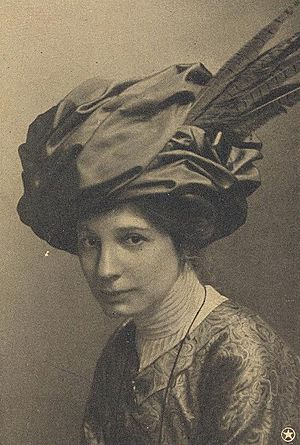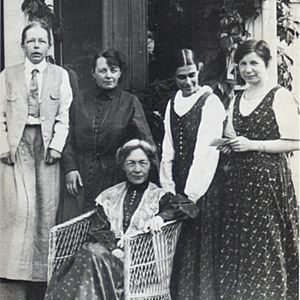Elin Wägner facts for kids
Quick facts for kids
Elin Wägner
|
|
|---|---|
 |
|
| Born | May 16, 1882 |
| Died | January 7, 1949 (aged 66) |
| Other names | Elin Matilda Elisabet Wägner |
| Occupation | Writer |
| Known for | Writer, journalist, feminist-pioneer, teacher, ecologist and pacifist, member of the Swedish Academy. |
Elin Wägner was an important Swedish writer, journalist, and teacher. She was born on May 16, 1882, and passed away on January 7, 1949. Elin was a strong supporter of women's rights, peace, and protecting the environment. She also became a member of the Swedish Academy in 1944, which is a very special honor for writers.
Contents
Elin Wägner's Early Life
Elin Matilda Elisabet Wägner was born in Lund, Sweden. Her father was a school principal. Sadly, Elin was only three years old when her mother died. This early loss may have influenced her later writings.
Fighting for Important Causes
Elin Wägner wrote many books and articles. Her work often focused on important topics like:
- Women's rights: She believed women should have the same rights as men.
- Voting rights: She strongly supported women getting the right to vote.
- Peace: She worked for peace and against war.
- Environment: She cared about protecting nature from pollution.
Elin is best known for her work in the women's right to vote movement in Sweden. She helped start the National Association for Women's Suffrage.
Helping Children and Education
Elin Wägner also helped create the Swedish organization Rädda Barnen. This group is the Swedish part of the International Save the Children Alliance. It helps children in need around the world.
She also helped develop a special school for women at Fogelstad. This school taught women about their civil rights and how to be active citizens. Elin herself was a teacher there.

A Leading Feminist Pioneer
Many people see Elin Wägner as one of the most important feminist pioneers in Sweden. She is often mentioned alongside Fredrika Bremer, another famous Swedish women's rights activist. A feminist is someone who believes in equal rights for all genders.
Elin Wägner's Writing Career
Elin Wägner was a very busy writer. She wrote many novels and articles for newspapers. She also wrote screenplays for films. From 1924 to 1927, she was the first editor of a political magazine called Tidevarvet.
Popular Novels and Themes
Some of Elin Wägner's most popular novels are still read today. They include:
- Norrtullsligan ("Men and Other Misfortunes", 1908)
- Pennskaftet ("The Penholder", 1910)
- Åsa-Hanna (1918)
- Kvarteret Oron ("Stormy Corner", 1919)
- Silverforsen ("The Silver Rapids", 1924)
- Vändkorset ("The Turnstile", 1934)
- Väckarklocka ("Alarm Clock", 1941)
- Vinden vände bladen ("The Wind Turned The Pages", 1947)
Her novels Dialogen fortsätter (1932), Genomskådad (1937), and Hemlighetsfull (1938) showed her strong belief in pacifism. Pacifism means believing that all war is wrong. She wrote about the threat of future wars in these books.
Her non-fiction book Väckarklocka (Alarm Clock) from 1941 talked about environmental problems. This was very early for such ideas.
Joining the Swedish Academy
Elin Wägner wrote a biography of another famous Swedish writer, Selma Lagerlöf. This book helped her earn a place in the prestigious Swedish Academy. Being a member of the Academy is a great honor for writers in Sweden.
Translations of Her Work
Many of Elin Wägner's books have been translated into other languages. They have been translated into French, German, Dutch, and Russian. More recently, some of her witty novels were translated into English in a book called Stockholm Stories (2002).
Personal Life
Elin Wägner was married to John Landquist from 1910 to 1922.
See also
 In Spanish: Elin Wägner para niños
In Spanish: Elin Wägner para niños

